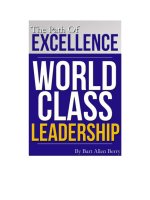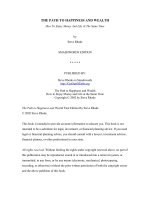Bài đọc 3.2. The Path to "Agile" Policymaking (Chỉ có bản tiếng Anh)
Bạn đang xem bản rút gọn của tài liệu. Xem và tải ngay bản đầy đủ của tài liệu tại đây (157.65 KB, 3 trang )
<span class='text_page_counter'>(1)</span><div class='page_container' data-page=1>
1/21/2020 The Path to "Agile" Policymaking | Government Innovators Network
1/4
Government Innovators Network
A forum for innovation in the public sector
0 Comments 58 Likes (/blog/path-agile-policymaking?rate=Ya7H2lCsi6wvASDl2tf9Ba4j4LZlNFeqpagtYnoYpYw)
Blog
PUBLIC MANAGEMENT (/BLOG/TOPIC/206)
OCTOBER 5, 2018
The Path to "Agile" Policymaking
By Arjun Bisen (/blog/author/111606)
To meet the expectations of citizens, allocate resources, and encourage accountability, governments are structured to plan projects in
advance in detailed policy cycles that respect hierarchies, annual budgets, and approval and review processes. But changeable and
fast-moving issues, which are increasingly common in the digital age, demand more exibility and responsiveness from government as it crafts
and implements policy
( By borrowing and adapting the “Agile
( project management methodology from the dynamic software and start-up worlds,
policymakers can thrive in an uncertain environment, increase civic engagement, and improve lives.
<b>What Is Agile?</b>
Scrum Process (Lakeworks/Wikimedia Commons)
</div>
<span class='text_page_counter'>(2)</span><div class='page_container' data-page=2>
1/21/2020 The Path to "Agile" Policymaking | Government Innovators Network
2/4
<b>AGILE</b>
<b>PRINCIPLES</b> <b>APPLICATION TO POLICYMAKING</b>
Focus on
customers
over contract
negotiations
Policies should focus on the end users/stakeholders. To
do this, policymakers need to understand user behavior
in detail and design policies to address their needs.
Policymakers should not delegate this step to
implementing agencies.
Prioritize
working
software
before
documentation
This refers to the art of maximizing the work not done.
Focus on delivering viable policy products to test and
iterate upon over documentation and communication.
While important, excessive documentation can limit the
ability of teams to adapt to change.
Encourage
individual
interactions,
not just
process
Rapid and regular informal communication is more
important than formal bureaucratic communication.
Verbal communication that is early and frequent will help
address barriers and challenges as soon as possible
without the need for lengthy memos and documentation.
Plan for
change instead
of following a
plan
Expect, welcome, and adapt to change. Design plans and
policies expecting your assumptions to prove false at
some point. Create rapid feedback mechanisms to better
understand the change underway. Do not wait for
end-of-program evaluations to seek feedback on policy
performance.
Agile methodology involves user-centered design, cross-functional teams, prototyping, rapid iteration, and continuous feedback loops.
Agile was created to maximize a team’s chances of delivering a reliable product that meets the user’s needs, while minimizing the risk of
failure due to environmental changes and limited testing. In an Agile process, multidisciplinary teams break down large products or projects
into smaller, discrete features and deliver these features one-by-one while testing for functionality and usability throughout the project.
In a government context, instead of working on each individual stage of a program or policy in isolation — for example, planning, design,
implementation, or testing/review, teams work to create successively improved versions of a “Minimum Viable Product” (MVP) that can be
tested directly with users. In a traditional linear development cycle, testing is done only with a comprehensive nal product — heightening
the potential risk of failure if user demands are poorly understood along the way.
Agile project management emerged from the 2001 Manifesto for Agile Software Development ( which listed 12
principles for software development. I have summarized the principles and how they can be applied to public policy below:
<b> </b>
<b> </b>
<b> </b>
<b> </b>
<b> </b>
<b> </b>
<b>How Do You Do It?</b>
Step 1: Form multidisciplinary teams that include not only policymakers but also policy implementers.
Step 2: De ne the various ‘users’ of the policy, and brainstorm the behaviors and characteristics that divide them into useful personas.
Conduct user interviews and/or observe user behaviors when they interact with the policy or program to understand user experiences and
points of friction. Users are not only the agencies who implement the policy but also end users who are a ected by the policy (e.g.,
businesses and citizens). Focus on behaviors and needs — not only on what users they say they want. Journey mapping
( is a useful exercise for understanding experiences with the policy. Tech
companies often hire a Product Manager ( whose primary job is to advocate for the
user’s needs in the organization.
Step 3: Analyze the problem as in any policy process (
ective-problem-solving/). Break the issue into policy features the users would be interested in, and that address speci c “user stories
( or needs.
</div>
<span class='text_page_counter'>(3)</span><div class='page_container' data-page=3>
1/21/2020 The Path to "Agile" Policymaking | Government Innovators Network
3/4
Public Management (/blog/topic/206) Governance & Politics (/blog/topic/163)
Step 5: Prototype and test the policy MVP with key users and stakeholders. You can test multiple policy ideas at once to understand the
strengths and weaknesses of each. Testing does not need to be excessively scienti c and rigorous; the main goal is to test your assumptions
in the real world. Get the policy in front of the users who matter most and understand its impact on their operations and behaviors.
Step 6: Consolidate learning into a nal product, while making time to re ect on and re ne your process through a sprint “retrospective
( One simple format is to ask each team member what the team should
start, stop, and continue doing in the next sprint.
Step 7: Compile successful policy features into the initial product for release. Include features in the product that can elicit regular feedback
from users. Continue to test and adjust the policy, or its implementation, even after launch. The learning should never end.
<b>When Agile Works Best</b>
Agile is a powerful methodology for development, but it is most successful in policymaking when teams know they have:
Clarity on policy objectives
Access to users and cross-sectoral teams
Stakeholder tolerance for uncertainty
Flexible timelines and sequencing
No clearly-de ned nal product
Tolerance for public engagement and failure
<b>Barriers to Agile in Policymaking</b>
There are many circumstances when Agile will have limited use in policymaking. In some cases, stakeholders will have limited tolerance for
uncertainty, making Agile inappropriate once the policy has been released. Some stakeholders who could su er in the case of volatility might
demand stability; in such cases, Agile is only appropriate during policy design.
Government is also structured to operate with di erent agencies responsible for discrete portfolios, often with clear delineation between
policy and implementation units. These divisions limit opportunities for creating cross-functional teams of policy experts, implementers,
analysts, and stakeholders.
The rigidity of budgetary and planning cycles restricts exploratory processes. It is di cult to attract and allocate resources when managers
cannot be speci c about the exact solution, process, and timeline an agency plans to follow in developing a policy.
That said, there is increasing use of Agile in government policymaking and it is achieving some success. The general principles of
understanding the user, working closely with implementers, user-testing assumptions, and iterating until the problem is solved, are all
policymaking best practices. I will highlight some examples of Agile in action in the public sector in my next post.
The views expressed in the Government Innovators Network blog are those of the individual author(s) and do not necessarily re ect those of the Ash
Center for Democratic Governance and Innovation, the John F. Kennedy School of Government, or of Harvard University.
<b>RELATED TOPICS</b>
( />
<b>Older</b>
July 24, 2018
Design Thinking for Better Government Services (/blog/design-thinking-better-government-services-human-centered)
<b>Newer</b>
</div>
<!--links-->
<a href=' project management emerged from the 2001 Manifesto for Agile Software Development ( />









